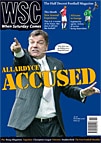 Errol Lawrence follows closely the movements of Zizou for 90 minutes, with the aid of 17 cameras
Errol Lawrence follows closely the movements of Zizou for 90 minutes, with the aid of 17 cameras
In 1970, a German film-maker named Hellmuth Costard pointed six 16mm cameras at George Best as he played for Manchester United against Coventry City. Footage was edited and framed so that other players and the crowd were ignored and, at most, incidental. Fussball wie noch nie (Football as never before) is not a film for the fan. Watching Best in less than splendid isolation is quite disturbing and, with the benefit of hindsight, the fascination and value of the film lies in its idiosyncratic study of what might be charitably described as an eccentric performance by football’s supreme individualist at the beginning of that long, sad decline.
Now, 36 years later, after a premiere at Cannes and appearances at the Edinburgh Film Festival, a film with the same concept has limited general release across the UK. Zidane: Un Portrait du 21e Siècle, is, in effect, a modern remake (the title means literally a 21st-century portrait) of Costard’s underground curio.
Of course, progress means that there are significant differences between the two films in scale and ambition. This time, 17 cameras mixing super 35mm and high-definition follow Zinedine Zidane’s every move and capture his every bead of sweat during Real Madrid’s league game against Villarreal at the Bernabéu in April 2005. The close-ups are incredible, the sound and image quality extraordinary and there is even what purports to be an insight into Zidane’s thought processes during the game. However, while exponentially “bigger” in scale, ambition and technical expertise, like most remakes the newer film is little more than an overblown imitation of the original.
Significantly, Costard had no interest in football and was merely fascinated by the image and physical appeal of Best. The makers of Zidane, Douglas Gordon, a Turner Prize‑winning Scot, and Frenchman Philippe Parreno, apparently see football as a vehicle for art and their protagonist as representative, yet such conceits mean that the film is a confused mixture of documentary and art installation, and nothing like football as we know it.
The film manages neither to deconstruct Zidane and the game nor properly convey the undoubted beauty of either. Dissonant affectations such as a voice-over and subtitles that convey Zidane’s reasoning at given moments and an incessant soundtrack militate against his “art” speaking for itself, and also fail to leaven the tedium of watching one man – albeit supremely talented – run, jog, walk, watch and mope in isolation. Which isn’t to say the film has no arresting moments: it becomes thrilling, and almost anthropological, on those occasions when Zidane is suddenly enlivened and moving with the power and grace of a big cat; and there is a delightful moment when Zidane, face as impassive and inscrutable as Buster Keaton for the most part, smiles broadly in response to a team-mate’s humorous aside. That small glimmer of humanity and enjoyment is something of a relief.
Zidane creates a goal and is dismissed after a familiar explosion of violence, but as well as failing to meet its artistic objectives the film’s narrow focus means that it lacks the narrative and drama of a real match. Isn’t it arrogant to presume that only this type of cinema can do justice to Zidane and “the beautiful game”?
Perhaps the best cinematic representation of a great footballer at work is Number 14, which films Johan Cruyff over the course of a season and contains footage that more accurately portrays the player and his sport by balancing context, space and perspective. Zidane, Un Portrait du 21e Siècle, while technically dazzling and occasionally viscerally thrilling, underlines the truism that football depends on these factors. Without them, for all its ambition and technical expertise, the film might even beg the question: “Is that all there is?”
From WSC 237 November 2006. What was happening this month